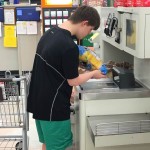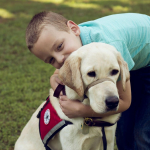Family Emergency Preparedness Training
LifeLine is also committed to helping families prepare for emergencies and potential interactions with emergency personnel. This preparation will include emergency preparedness for major community crisis or catastrophic events as well as preparation for personal emergencies that may occur at home, in the car, or in the community. What are the things that parents can do/have, etc. that would help them, the one they care for, and the first responder most in a crisis if emergency personnel were called to their home, car wreck, or medical emergency in the community? It is our goal to equip families with information and resource they need to be prepared.
Besides training for families, LifeLine is offering stickers to identify your car or home. Metro Chattanooga first responders are  being trained through SNAP’s first responder training to look for this symbol and then they will look for a Family Special Needs Emergency Contact Form in the glove box of the identified vehicle or close to the front door of an identified home. You may also take a copy of the completed form and drop off or mail it to the 911 center for them to enter into the 911 database so that anytime a call goes in to your address, the information about your loved one with special needs will available as they respond. You may contact Skyler at the contact information below to get a sticker or they will be available at LifeLine trainings and events. You can download a Family Special Needs Emergency Contact Form here:
being trained through SNAP’s first responder training to look for this symbol and then they will look for a Family Special Needs Emergency Contact Form in the glove box of the identified vehicle or close to the front door of an identified home. You may also take a copy of the completed form and drop off or mail it to the 911 center for them to enter into the 911 database so that anytime a call goes in to your address, the information about your loved one with special needs will available as they respond. You may contact Skyler at the contact information below to get a sticker or they will be available at LifeLine trainings and events. You can download a Family Special Needs Emergency Contact Form here:
HC911 Special Needs Contact form update 2016 and details about where to place your stickers and how to send a copy to 911 can be found here: SNAP Sticker Instructions.
_____________________________________________________________________________
 There are multiple types of emergencies. Try as we might, it is impossible to prepare for every eventuality. However, there are steps we can take to be basically prepared for both a shelter in place and evacuation scenario. This page is a summary of some of highlights of our Family Preparedness Training Workshop offered throughout the year to help families affected by special needs and disability be more prepared to face a crisis.
There are multiple types of emergencies. Try as we might, it is impossible to prepare for every eventuality. However, there are steps we can take to be basically prepared for both a shelter in place and evacuation scenario. This page is a summary of some of highlights of our Family Preparedness Training Workshop offered throughout the year to help families affected by special needs and disability be more prepared to face a crisis.
1. Know your risk. Know the hazards around your home, work, and frequented locations.
- Know the emergency and evacuation procedures of schools, workplaces, childcare providers, and nursing homes where your loved ones spend their time. Know evacuation routes from each of these locations as well as your home.
2. Prepare documentation. Digital copies are great, but in the event of power outages, hard copies would be necessary. Carrying a jump drive with information, uploading to Dropbox, or emailing to family or friends would be helpful as well as having a notebook or folder with hard copies of documents to carry with you.
- Birth certificates
- Marriage certificates
- Bank information and contact information
- Social security cards and numbers
- Credit card numbers and contact information
- Home & Vehicle Insurance information
- Phone numbers for claims
- Deductible information
- Certificates/proof of insurance
- Medical Information
- Medical insurance cards & contact information
- Basic medical records
- Immunizations
- Diagnosis and treatment plans
- Doctors, Therapists, & Contact Information
- Passports
- Drivers License
- Wills/Trusts
- Conservatorship/Guardianships/Powers of Attorney
- Deeds to property
- Titles to vehicles
- Durable Medical Equipment & Supply List
- Model numbers
- Serials numbers
- Order numbers
- Supplier contact information
- Inventory Lists
- Written list of home inventory
- Video clips of home inventory
- Photo book of home inventory
- Any other documents specific to your family that would be necessary
3. Document your plans for evacuation and sheltering in place, including meeting places and contact points.
- Emergency Family & Friend Contact List
- Local
- Out of State
- Evacuation Plan
- Local
- Out of State
- Transportation Plan
- Local
- Out of State
4. Create checklists specific to your family members and their needs.
- Shelter in Place preparation checklists
- Evacuation preparation checklists
- Create checklists for personalized individual evacuation kits

- Create checklists for family evacuation kits
- Create checklists for personalized individual evacuation kits
- Create checklist for First Aid Kit
- Create checklists for Medication Kits
- Create checklists for Pet Kits
- Create checklist for Sensory Kits
- Create checklist for Vehicle Kits
5. Pack kits from the checklists you have created.
A. Shelter in Place family packing checklist
- Two weeks stock of food and water
- Plan for one gallon of water per person per day
- Canned, dried meats, soups, fruits, vegetables
- Manual can opener
- Peel off tops (fruits, applesauce, pudding, etc.)
- Granola bars, crackers, nuts
- NOTE: Take sensory issues, allergies, etc. into consideration when planning for food
- NOTE: Pack in plastic tubs or coolers vs. cardboard boxes in case of flooding
- Sterno cans or fuel for outdoor cooking without power
- Tarps, duct tape
- Water filters, treatment tablets, purification tablets
- Hand warmers or battery powered fans

- Paper supplies
- Backup power sources
- Generators or charging devices
- Power plan with local fire department or hospital for power for medical equipment
- Radio for alerts – battery, crank, solar
- Pack activities that do not require power and don’t take up a lot of space
- Travel or card games
- Pet/Service Animal food/water/meds for two weeks
- NOTE: If you live in an area in danger of looting, consider protection
B. Create personalized checklists for evacuation
- Name
- Identifying information
- Contact information
- Diagnoses
- Kits you will need to grab for each person (Medication, Sensory, etc.)
- Other things that may not be pre-packed needed for spur of moment evacuation
C. Pack backpacks for each (Thrift stores will keep cost down!)
- Documentation/Identification (see Identification #8 below for information to include)
- Food/Water for 3 days (1 gallon per person per day)
- Dried, canned, prepackaged foods
- Hygiene items
- Medications (maintenance drugs, rescue meds, OTC meds)
- Basic first aid
- Flashlights/Batteries
- Candles/waterproof matches
- Cash in small bills
- Whistle
- Manual can opener
- Infant, adult, senior as needed
- Diapers, Pullups, Depends, Hygiene Items
- Wipes, Cream
- One or two changes of clothing
- Close – toed shoes
D. Pack Pet/Service Animal Evacuation Kits
- Food
- Water
- Medications
- Leash

- Photo identification/documentation
- Documentation of service animal status
- Immunization record
- Carrier (will be needed in shelter)
- Litter
- Pack one per animal in case the animals get separated from you or each other in evacuation process
6. Don’t forget a communication plan!
- Contact points locally and out of state to request help or check-in safe
- Alternate and augmentative communication systems (and printed paper backup if power is unavailable!)
7. Plan for transportation.
- Be sure you are not relying on a transportation system that will be unavailable in crisis or is committed elsewhere during an event.
8. Identify yourself and your loved ones in case there arises a situation where you or they will not be able to communicate information.
- Put SNAP Stickers on your home and car (Contact LifeLine! More info here SNAP Sticker Instructions)
- Biography sheets (Print on here: HC911 Special Needs Contact form update 2016) (If you live outside of Hamilton County, you may be able to find your county’s contact information and process here: SNAP – 911 Emergency Database 2019)
- Register with Take Me Home. a free program provided by the Chattanooga Police Department that enables first responders to search by photo, physical description, etc. You can learn more here: Take Me Home Flyer
- Identify emergency contacts
- Identify basic medical information (diagnoses, medications, allergies, where medical records can be found, etc.)
- Identify ways to facilitate processing of emotions
- Identify ways pain response processing might be different
- Identify behaviors that may be forms of communication
- Identify de-escalation strategies
- Identify sensory concerns
- Identify best ways to communicate (verbal, visual, extra processing time, writing,etc.)
9. Prepare and teach ahead of time.
- Social stories
- Role playing
- Practice
- Meet with first responders in your home/vehicle for walk through
- Students: Build in communication and emergency preparedness into transition IEPs
- Adults: Work with waiver providers to develop evacuation and emergency response plans
- Seniors: Work with family/senior service providers to develop evacuation and emergency response plans.
- Build relationships with first responders in your neighborhood
10. Consult Additional Resources
- FEMA
- National Safety Council
- Ready.gov
- CDC
- YouTube has multiple videos
- Kids Guide to Building a Disaster Supply Kit
Meet SNAP’s Family Trainer – Lisa Mattheiss
 In 2008, as a member of the National Council on Disability, Lisa Mattheiss listened to a gut-wrenching three day testimony from Hurricane Katrina responders and survivors. Lisa’s conclusion was that many things could have been different. Many lives could have been spared with better preparation. As the parent of a now 20 year old with spina bifida and multiple other disabilities, she vowed not to let that happen on her watch if she could prevent it. When Skyler approached Lisa about First Responder training in 2016, she knew Family Preparedness Training needed to be included as a component of the Special Needs Awareness Program.
In 2008, as a member of the National Council on Disability, Lisa Mattheiss listened to a gut-wrenching three day testimony from Hurricane Katrina responders and survivors. Lisa’s conclusion was that many things could have been different. Many lives could have been spared with better preparation. As the parent of a now 20 year old with spina bifida and multiple other disabilities, she vowed not to let that happen on her watch if she could prevent it. When Skyler approached Lisa about First Responder training in 2016, she knew Family Preparedness Training needed to be included as a component of the Special Needs Awareness Program.
Lisa Mattheiss with Skyler Phillips developed the curriculum for the Family Emergency Preparedness training with input from several other first responders, current and former police officers, military and civilian emergency medical personnel and multiple parents.
To request a Family Emergency Preparedness Training for your church, school, or community organization, contact us here.

